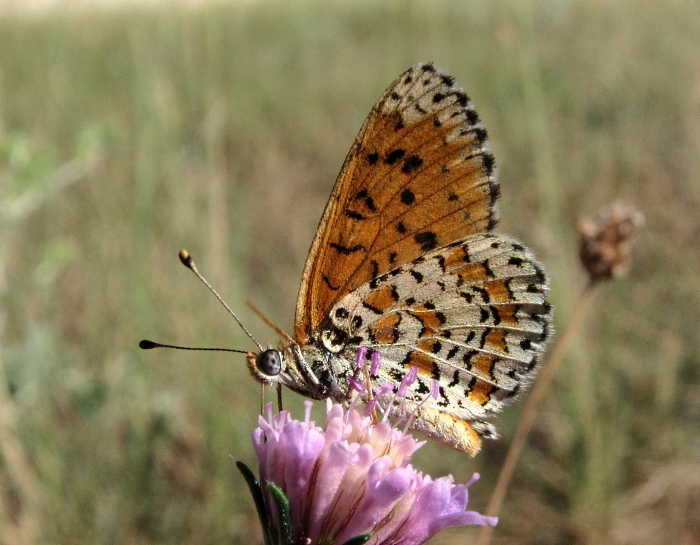Re: Butterflies of Var, Southern France
Posted: Wed Jul 31, 2024 9:07 am
Correction – the underside image is not of the Melitaea in question. It was taken on 8 July at a site known for aurelia as the upperside showed some indication of aurelia, but I am fairly sure it wasn’t. So the reservations we all expressed about the unf s2 heavy shading would no longer apply.
Which still raises the question as to what it is, if we can ever know.
I throw out some thoughts:
I see a lot of athalia (in its various forms) all across France where it is widespread and sometimes common. It is very variable in its markings. I have never seen one looking even remotely like this one, even allowing for the fact that it is, or may be, to some degree an aberration. It was quite noticeably small and the flight was weak, although as it is a female, that may be less convincing.
The question mark really hangs over aurelia. We are familiar with the “lowland form”, its rather regular bands and flight pattern. But it also occurs up to 1900m and the upper reaches of the Durance are a stronghold (see the maps in the CEN-PACA Atlas) where the altitude is in the range 1600-2000m and these aurelia resemble the lowland form quite closely, but can also deviate to quite a degree. It does not appear (in France at least) to fly at intermediate altitudes. Which raises the question: how far can it deviate from the regular pattern of the lowland form? What is it about the ones that don’t look like the lowland form that says they are aurelia?
It is also true that aurelia and athalia can fly together and athalia has to a greater or lesser degree the regularity of bands that defines aurelia. I have images of athalia that, were it not for the location, could easily be candidate aurelia.
Looking at trusted sites:
Matt Rowlings has many images, showing a wide variation in markings, some very different from classic (including one that looks 100% athalia to me).
Philippe Bricaire has a number images, some classic from Switzerland, but some from the upper Durance at altitudes of 1600-1900m, including one female that looks far removed from classic. Philippe is a very thorough analyst whose IDs I would be reluctant to question.
I have images from the upper Durance at 1900m which have been identified as aurelia by Philippe, where the females were more heavily marked than the males (as is often the case for athalia), plus the underside of a male that clearly confirms that aurelia was flying there.
It seems to me that there is little information on the altitude form. I will dig deeper when I am back in October.
Roger
Which still raises the question as to what it is, if we can ever know.
I throw out some thoughts:
I see a lot of athalia (in its various forms) all across France where it is widespread and sometimes common. It is very variable in its markings. I have never seen one looking even remotely like this one, even allowing for the fact that it is, or may be, to some degree an aberration. It was quite noticeably small and the flight was weak, although as it is a female, that may be less convincing.
The question mark really hangs over aurelia. We are familiar with the “lowland form”, its rather regular bands and flight pattern. But it also occurs up to 1900m and the upper reaches of the Durance are a stronghold (see the maps in the CEN-PACA Atlas) where the altitude is in the range 1600-2000m and these aurelia resemble the lowland form quite closely, but can also deviate to quite a degree. It does not appear (in France at least) to fly at intermediate altitudes. Which raises the question: how far can it deviate from the regular pattern of the lowland form? What is it about the ones that don’t look like the lowland form that says they are aurelia?
It is also true that aurelia and athalia can fly together and athalia has to a greater or lesser degree the regularity of bands that defines aurelia. I have images of athalia that, were it not for the location, could easily be candidate aurelia.
Looking at trusted sites:
Matt Rowlings has many images, showing a wide variation in markings, some very different from classic (including one that looks 100% athalia to me).
Philippe Bricaire has a number images, some classic from Switzerland, but some from the upper Durance at altitudes of 1600-1900m, including one female that looks far removed from classic. Philippe is a very thorough analyst whose IDs I would be reluctant to question.
I have images from the upper Durance at 1900m which have been identified as aurelia by Philippe, where the females were more heavily marked than the males (as is often the case for athalia), plus the underside of a male that clearly confirms that aurelia was flying there.
It seems to me that there is little information on the altitude form. I will dig deeper when I am back in October.
Roger

